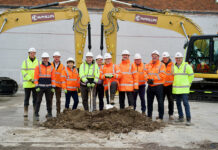
NEW research has revealed construction workloads in Scotland were stable through the first quarter of 2025.
The findings are according to the latest Royal Institution of Chartered Surveyors (RICS) Construction Monitor.
Workloads in infrastructure and private housing rose, with both seeing net balances of 9%. However, net balances of the rest of the sub-sectors were in negative territory, though relatively marginally so: public housing (-3%), private commercial (-10%), private industrials (-8%) and other public works (-9%).
Although overall workloads remain flat, the survey found that surveyors are more optimistic on the 12-month horizon. A net balance of 19% of Scottish respondents expects workloads to rise over the next year, which is slightly above the UK average of 17%.
However, surveyors are cautious on the outlook for profit margins. A net balance of -6% of Scottish respondents anticipate profit margins will fall over the next year, down from 13% seen in Q4 2024.
Surveyors also continue to report shortages in skilled workers. 56% of survey respondents noted a shortage in quantity surveyors, up from 49% in the last survey, while 42% reported a shortage in bricklayers, up from 35% in Q4 2024. 39% noted a shortage in other construction professionals which was similar to the result in the survey previous.
Survey respondent Christopher Alexander Marshall of Lundin Homes Ltd in Glenrothes said the main issue encountered as a private housebuilder is the lack of skilled tradespersons.
David Shaw of Torridon Cost Consultancy in Edinburgh commented, “Costs remain higher than last year, with many forecasting increases due to the changes in employer national insurance contributions. The development pipeline has reduced across the market, so contractors are keen to fill order books and there is a nervousness from many about the construction market in 2025.”
Commenting on the UK picture, RICS chief economist Simon Rubinsohn said, “Construction activity was largely flat over the quarter with respondents expressing a little more caution in the face of the heightened level of uncertainty both at a global and domestic level. In particular, concerns about the implementation of tariffs and what this might mean for costs and economic activity as well as the potential impact of the uplift in employer NI contributions are highlighted in the feedback.
“Significantly, aside from financial issues the most cited obstacle to activity referenced in the survey is planning and regulation which chimes neatly with the government’s agenda. Addressing this issue is critical if the ambitions around housing and infrastructure are to be met. That said, for now the forward-looking metrics point to a relatively modest uplift in construction workloads over the next twelve months with profitability in the sector remaining under pressure.”










